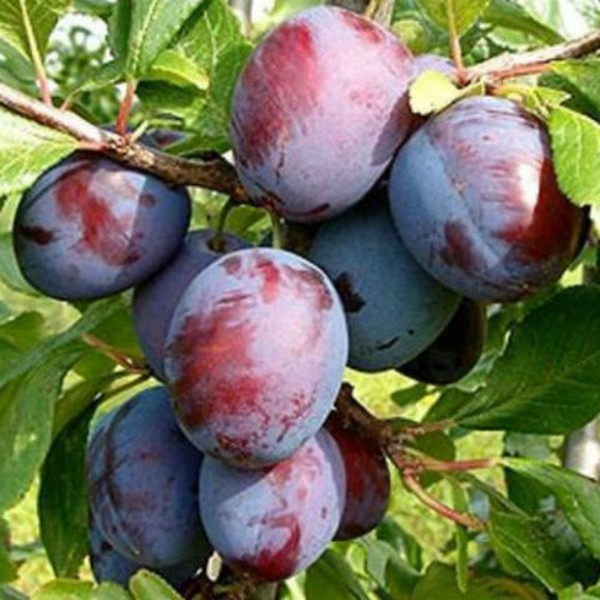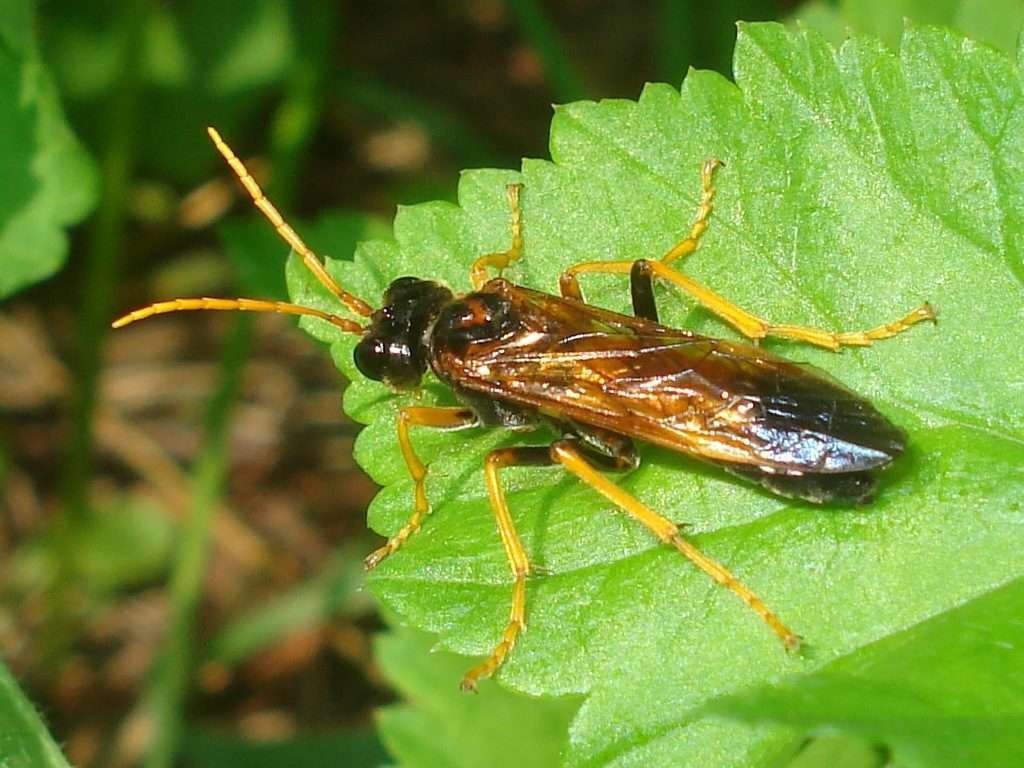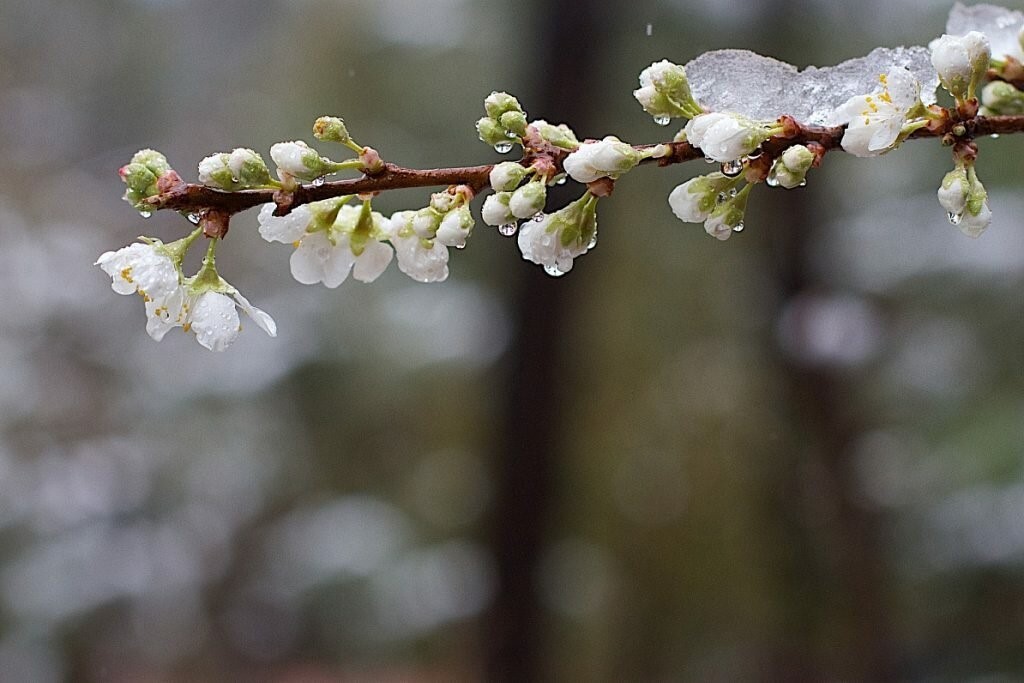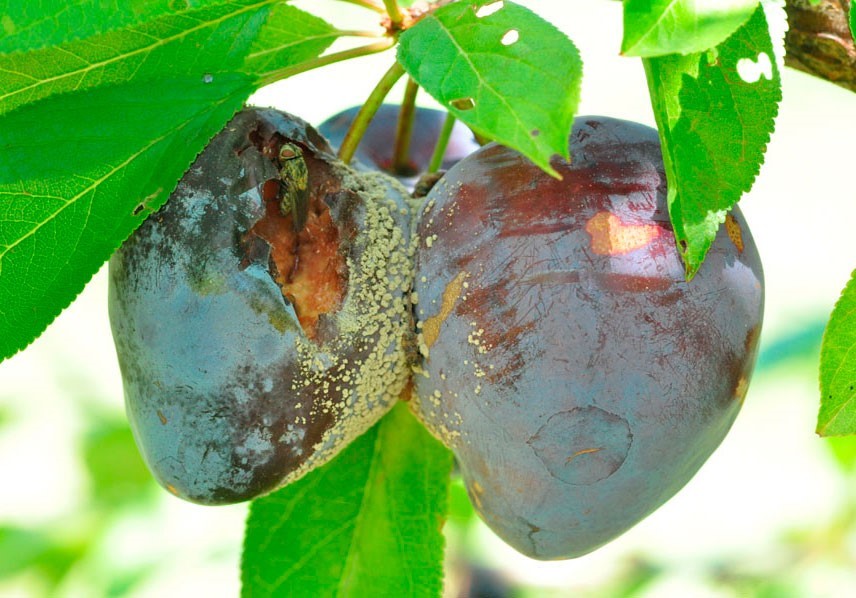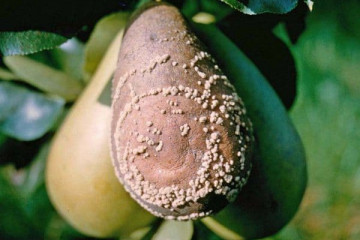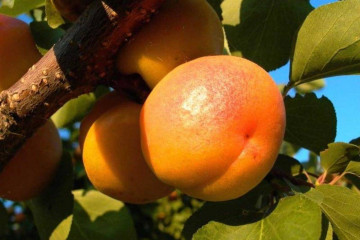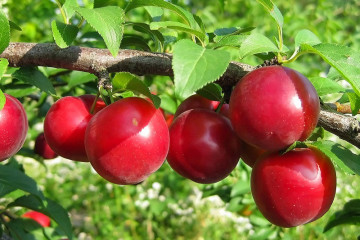Why plum sheds green fruits before ripening
Content:
The abundant flowering of plums in May does not guarantee that the same harvest will occur in August-September. There are years when the tree drops unripe fruit already at the beginning of summer. The article will help you figure out why the plum sheds green fruits and how to prevent the death of the crop.
Why do plums fall off fruits
There are many reasons why the plum is crumbling.
This includes freezing during flowering, problems with pollination, lack of moisture and nutrition, diseases, pests, too abundant harvest, unfavorable weather, especially during the flowering period, drying out of the tree. If the spring bloom was successful, the reasons for the fruit falling may be as follows:
- Little ground moisture. Plum fruits appear in early June, and during this time there are often droughts. Because of this, the roots of the plum have nothing to feed the growing fruits, they do not have enough resources, the result is a fallen ovary.
- Excess water. It also has a detrimental effect on the root system. Root decay begins, followed by shedding of the crop.
- Pests. Plum sawyer is a frequent “guest” on the plant. Pest larvae like unripe pulp and bones of an unripe embryo. This is the reason why the plum sheds before ripening.
Plum moth
The plum moth insect is the main pest that damages fruit trees. The habitat is extensive, but it is most often found in the southern regions of Russia. The butterfly is grayish with a slight brown tint. The larva is a scarlet caterpillar. The activity of the pest is easily identified by the drops of gum on the surface of the damaged fruit.
The methods of struggle are varied. The arsenal includes both biological and chemical methods. Biopreparations "Iskra-Bio" and "Fitoverm" have proven themselves well. The action of the funds is based on the death of the pest from the activity of microorganisms that are not harmful to humans. Trees must be processed on a windless and dry day. The disadvantage of bio-treatment is that the reagent is washed off by rain.
Chemical means of protection include "Fufanon", "Karbofos", "Kinmiks" and similar preparations. They should be used according to the instructions provided.
Poor pollination
Plum crop failure is often caused by insufficient pollination. Crop varieties are divided into 4 types:
- self-pollinated;
- self-pollinated partially;
- sterile;
- sterile.
Plum blossoms are cross-pollinated, bees are best suited for this. In early spring, during flowering, cold snaps occur and the activity of bees decreases.
Self-pollinated varieties are guaranteed to give a good harvest of large fruits, they are not hindered by bad weather. Cross-pollination of even self-pollinated varieties allows you to get the maximum number of ovaries in the spring and a guaranteed harvest in the summer. Other varieties of plums do not form an ovary at all when pollinated.
Plum sawfly
This insect is the most dangerous for plum trees.Having settled on plants, it destroys them. The culture ceases to bear fruit or spoiled fruits are formed that do not have time to ripen. If every year more and more wormy fruits appear, the lion's share of which falls green, this is the business of a black or yellow plum sawfly.
There are two ways to deal with the sawfly:
- Mechanical. Its essence is in the removal of opal fruits with their subsequent disposal. Plums are burned or boiled, followed by burying them into the ground to a depth of more than half a meter. At the beginning of summer, all wormy and fallen plums should be removed. The larvae of the pest are dealt with with the help of the autumn digging of the site near the damaged trees. When frozen, the larvae die.
- Chemical. Chemicals are used in the form of acaricides and insecticides. The most common is Karbofos. The drug is used in a concentration of up to 0.3%. Trees are sprayed in late spring, about a week before flowering. Re-processing should be done at the end of flowering.
Improper watering
Plum can also shed green fruits due to insufficient or improper watering. The roots of the plum tree do not grow into the depths of the earth, but spread close to the surface. If the surface layer does not have good moisture, the fruit lacks nutrition. This is the answer to the question of why the plum is crumbling. The fruits will fall off until the tree has enough strength to feed them.
It is advisable to water the plum more often and abundantly. Otherwise, the developing ovary will fall off immature. In hot weather, if you ignore watering, two weeks after flowering, the green plum will begin to crumble half-ripe. When watering plums, it is worth considering:
- Regional climate.
- The depth of the aquifer.
- The amount of precipitation.
The number of other trees growing with the plum should be taken into account - they also pretend to moisture. It is necessary to water with the calculation of soil moisture to a depth of half a meter. Excessive moisture will also not yield a generous harvest. Plum does not like abundant watering and can shed the fruit embryos while still green.
Spring frosts
Protecting trees from frost in spring by using smoke is not always effective. The most effective method is to delay flowering. In order to delay the appearance of flowers on the plum in spring, in autumn the near-trunk areas of the soil should be mulched with peat to a depth of 15 cm. Unfortunately, by January this layer completely freezes. To prevent this from happening in the near-trunk area, it is necessary to accumulate a layer of snow up to 40 cm thick. From above, cover all this with a layer of sawdust up to 15 cm, then with another layer of snow.
With the arrival of spring, the snow laid on top of the sawdust quickly melts, and the one under them lays longer. Under this snow, in a frozen state, there is a mulching layer and soil with a root system. As the temperature rises, all layers of the soil gradually thaw, retarding the development of the plant for a period after which a stable warmth sets in.
Despite the warming, flowering is delayed until the second half of May after thawing of the near-trunk layer of the winter “pie”. Thus, it is possible to avoid the fatal cold for the ovary of most fruit trees, the plum is no exception.
Fungal diseases
The fungal disease quickly conquers trees, transferring to neighboring plants. High humidity and temperature, dense crown are excellent conditions for fungus. Rainy and warm summers are most conducive to this. The main weapon is fungicides.
Most often, plums are affected by such fungi:
- Coccomycosis is dangerous mainly for the leaves of the culture, but sometimes the ovaries and shoots suffer.Symptoms are reddish-brown or purple spots. For the fight, a 1% solution of copper oxychloride or Bordeaux liquid is used.
- Rust affects the green part of the plant, does not allow the fruits to ripen. Symptoms are red (rusty) spots. Treatment - 1% solution of copper sulfate or Bordeaux liquid.
- Gnomoniosis (brown spot) - reddish-brown spots on the leaves. Treatment - 1% solution of copper sulfate.
- Clasterosporium - brown spots with a framing red border. Symptoms - holes appear in the leaves, and after a while the entire aerial part of the plant is affected. Treatment - 3% Bordeaux fluid solution. It should be processed in the fall after dropping the foliage.
Lack and excess of fertilizers
The lack of fertilizers affects the growth of the culture and its development, the excess is deposited in fruits and, as a result, enters the human body. Balance is essential. To determine the lack of feeding, the crown of the tree is examined.
With a deficit:
- nitrogen - weak green mass, sluggish growth, pale green foliage or small yellow leaves, medium-sized fruits;
- potassium - dry fragments on the leaves, uneven formation, deformation, chlorotic color in the leaves;
- phosphorus - early shedding of leaves, late flowering, ripening and fruiting, dull color of plums, yellow shades of leaves.
- magnesium - spruce color of the leaves, the veins of the leaves are brown.
Excess nitrogen leads to significant growth, lack of flowers and buds. The tree seems to grow fat. Shoots do not ripen by winter and freeze slightly, gum flow appears, frost breaks can form on the drain in any part.
Plum aphid
To combat aphids, consideration should be given to the extent of damage, weather, plum height, and personal preference. Both folk remedies and chemical ones can be used. Aphids suck out juices, destroy inflorescences, and reduce the tree's immunity to many diseases. Many species of aphids live on the plum. You can find out why plum fruits fall off by deformed leaves with rot, spots and mold. If not taken care of, the health of the tree and the yield will be in doubt.
Aphids can be destroyed mechanically with a pressurized water jet. In any case, the infected leaves will fall off, but it is better to pick them off immediately. In autumn, after leaf fall, trees are carefully examined for the presence of aphid eggs. The soil around the trunks is dug up, sprinkled with ash and poured with hot water. From folk remedies to combat aphids, vinegar, tar soap, garlic, and ammonia are also used.
Viral diseases
Unfortunately, plum viral diseases are 100% incurable. Birds and insects carry viruses. Plumpox (sharka) manifests itself in the form of stripes, spots and fruit falling off. The virus is spread wherever the plum grows. He feeds on the contents of the fruit. That is why the plums are still green. Dents appear at the site of the lesion, plums wrinkle, become tasteless and cannot be consumed. The affected crop falls off the trees ahead of schedule. It will not be possible to exterminate the virus. The diseased tree must be destroyed.
Tree dwarfism is caused by a virus that lives in birds and mammals. The infection enters the culture stem through contact with them. At first, the growth of shoots slows down, then the leaves are deformed and reduced. Virus-infected leaves accumulate on the tops of the branches, and the development of new ones is suspended. It is impossible to cure the disease, the result of the viral lesion will be the death of the tree. It must be burned along with the root system.
Control measures
You can prevent crop loss if you follow a number of measures. The main thing is to water on time. This is especially true in the spring when the trees wake up after winter. The roots of the plums are shallow, so they cannot extract moisture from the ground. In spring, the surface layer dries quickly, so timely watering is very necessary. Otherwise, the opening ovary will die.
Top dressing should also be included in a set of priority measures. The fruit tree can be fertilized with both mineral compounds and organic ones. They should be diluted in water. From organic matter, mullein is good, and from minerals there are two types of nitrate - calcium and potassium. Mullein is prepared in a proportion of 1 kg per bucket of water, bird droppings 1:15, saltpeter is bred at the rate of 1 tbsp. l per 10 l of water. To feed a young seedling, 30 liters of solution is enough, up to 40 liters should be poured under an adult tree.
The next factor that causes plums to fall before ripening, to which you need to pay attention, are pests. How to deal with them is described above. If the ovary and green fruits still fall off, then spring frosts, poor pollination and a deficiency of magnesium, phosphorus, nitrogen in the soil may be the culprit.
Correct plum care
The content of the fruit tree has its own characteristics. Plum loves water. This should be monitored and watered once a week during dry periods. How much to pour - indicated above. When underfilling, the skin of the fruit cracks, and from excessive watering the leaves turn yellow.
In winter, it is advisable to shovel and tamp the snow around the tree, shake it off the branches. You should take care of the area near the plum all year round. It must be at least 2 meters in radius. The soil is cleared of weeds, loosened up.
Prevention of pests and diseases
In order to prevent plum diseases, a number of simple rules should be observed:
- Avoid neglect of the garden.
- Sanitize and prune trees regularly.
- Fight weeds
- Fertilize and feed trees in a timely manner.
- Avoid the appearance of ants.
- Treat trees with antifungal drugs.
To combat pests, you need:
- In the spring, sprinkle the trees with insecticides until the awakening stage.
- During the period of flower formation, re-treat with insecticides.
- Then repeat the same procedure at the ovary stage.
- Subsequent treatments with drugs are carried out as needed.
Disease and pest control is carried out all year round.
Plum is a plant that loves a reverent attitude towards itself. To get a good harvest for many years in a row, the tree needs the attention and care of the owner. You should start by choosing a planting method and time. Fertilizers and agricultural technology are important, this has its own subtleties.
